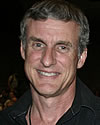 Steven Squyres |
2015 President's Medal
Presented to Steven Squyres
Citation by Hap McSween
Steve Squyres, GSA’s 2015 President’s Medalist, is responsible, more than anyone else, for teaching us how to do robotic field geology on the surface of another planet. This is no mean feat. The logistics, if they can be called that, for planetary exploration are overwhelming, the required technologies are fiendishly complex, the hazards and uncertainties are formidable, the sheer number of participants is daunting, and the mission duration can exceed a decade.
As Principal Investigator for the Mars Exploration Rovers (MER) mission, Steve recognized the importance of adding geologists with terrestrial field experience to the Spirit and Opportunity science teams. He conceived and implemented an organizational structure that took advantage of this experience in strategic planning and incorporated the orderly utilization of rover instruments based on science goals. He also refined an operations structure that allowed a large team of scientists and engineers to work together seamlessly and efficiently in making quick decisions for daily rover operations. Overcoming technical obstacles too numerous to elaborate, the MER team under his guidance mapped geologic traverses that extended far beyond the rovers’ designed lifetimes, characterized hundreds of rock samples, and developed comprehensive geologic histories for the two rover sites (one volcanic and one sedimentary). Steve’s leadership in repeatedly focusing the rover team on key scientific questions has been instrumental in the most successful geologic forays to explore another planet’s surface.
Steve will surely deflect credit to his talented team of scientific collaborators who build instruments and interpret their data from afar, to the engineering wizards who construct and operate mechanical rovers that do amazing things, and to the software designers who craft programs that make possible rover operations. But with this medal GSA recognizes the seminal contribution that Steve has made to geoscience – specifically, innovative applications of the principles and practical methods of field geology to the robotic exploration of another planet. This accomplishment will find wide application in future planetary excursions, and has greatly expanded the public visibility of, and appreciation for, the discipline of geology, albeit on another world.
 2015 President's Medal — Response by Steven Squyres
2015 President's Medal — Response by Steven Squyres
This award is given very generously, and is received very gratefully. When we began working on what became Spirit and Opportunity more than two decades ago, we knew that we wanted to do geology with robots, but we had no idea how. I remember the first time we took a test robot, called FIDO, out to the Mojave Desert, at a place called Silver Lake. We carried it out to a place where there were a bunch of rocks, we set it down, and then we stood there scratching our heads and said “okay, now what?” We had no idea what we were doing. Transitioning from the naive confusion of those days to the finely honed Mars rover operations processes of today has been one of the most interesting intellectual journeys of my career.
Of course, it has been a journey that has been taken together by many. I find particular irony, and a strange mixture of awkwardness and indebtedness, in receiving an individual award related to something that is at its core a deeply collaborative process. I have to express special gratitude to Ray Arvidson, who has been my partner and friend through all the years that we’ve worked on Spirit and Opportunity, from the very beginning right up to yestersol. More than a hundred other members of the Mars Exploration Rover science team have made their own vitally important contributions. And no matter how much scientific brainpower we manage to harness in the name of robotic field geology, none of it would be possible without the dedicated efforts of the engineers. These include not just the engineers who work long hours every flight ops day to write, check, and re-check the commands that go to the vehicles. They also include the small army of fiercely dedicated engineers who built these remarkable robots in the first place.
So I thank the GSA, and its President, for this honor, not on behalf of myself, but on behalf of the literally thousands of people who have made this journey possible.
